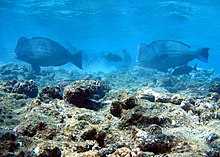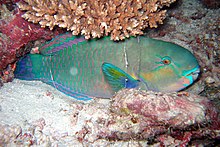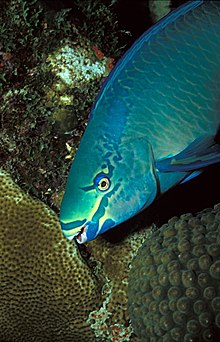Parrot fish
| Parrot fish | ||||||||||||
|---|---|---|---|---|---|---|---|---|---|---|---|---|

Blue- banded parrotfish ( Scarus ghobban ) that migrated to the eastern Mediterranean through the Suez Canal |
||||||||||||
| Systematics | ||||||||||||
|
||||||||||||
| Scientific name | ||||||||||||
| Scarinae | ||||||||||||
| Rafinesque , 1810 |
The parrot fish or sea parrots (Scarinae) are a subfamily of the wrasse (Labridae) and belong to the perch relatives (Percomorphaceae).
Occurrence and way of life
Parrotfish inhabit large groups exclusively in tropical seas. Most species live as grazers on coral reefs . Some inhabit seagrass meadows and the upper zones on rocky reefs. With their beak-like teeth, they graze the low vegetation cover on the exposed limestone surfaces of the coral reefs. The sediment is also removed. Other species let the sediment stand and only feed on the plants, such as thread algae . Through this diet, parrotfish contribute significantly to the natural erosion of coral reefs, so that the balance between corals, seaweed and algae is maintained, at the same time they create the basis for the growth of new corals. Species of the genera Sparisoma , Scarus and the buffalo-head parrotfish ( Bolbometopon muricatum ) feed primarily on living corals, which is why they are considered "harmful".
At night, some species secrete a cocoon of mucus in which they go to rest. The cocoon is open at the front and back so that the water can flow through. Other species sleep in crevices. Recent studies by Alexandra Grutter et al. from the University of Queensland, the mucus cocoon serves to ward off blood-sucking seaweed.
features
Your jaw teeth have grown together to form a beak. The lower jaw contains an additional joint to increase the crush pressure on the fused teeth. A modified pharyngeal apparatus forms a second substitute for the jaw in the throat. The lower pharyngealia are fused and articulate inside the shoulder girdle. The pharynx are arranged in rows. The sea parrots grind the food, which consists mainly of plants, between the upper and lower pharynx to a fine paste.
Reproduction
Parrotfish have a complicated way of reproducing; like many other wrasse, they are hermaphrodites . These are proterogynous hermaphrodites , that is, they are initially females and later males.
Color phases
There are up to three color phases that are run through. While the fry mostly belong to the female sex, the individuals of the terminal phase are male.
- The juvenile phase is the not yet sexually mature phase of the fish. The parrotfish sometimes have a pattern similar to that in the subsequent initial phase.
- As the fish ripen in the initial phase , they take on a red to gray to brown color. In this phase there are mostly females. The few primary males can only be distinguished by their behavior during spawning and by their internal anatomy. Some species do not have primary males and they do not change color. The number and absence of IP males depends on various factors that are not yet adequately understood.
- Over time, the individuals in the initial phase change their color and take on the color of the terminal phase . The females change sex. The primary males also change color and are then referred to as secondary males. In this phase the fish are always sexually mature males.
The secondary males either keep a small harem or occupy temporary breeding places. In these cases, only one TP male and one IP female are involved in spawning. During the spawning act it can happen that primary males sneak the spawning act. They approach the pairs in the color of a female and when spawning they release large amounts of sperm into the water. Because of their larger testicles, they have a greater capacity to fertilize the eggs than the TP males. During mass spawning, both of them give off their sperm.
Systematics
The parrot fish are usually led as a separate family (Scaridae) of the perch-like (in the traditional sense). However, recent studies indicate that they must be counted among the wrasse as a sister group of the kingfish.
| Labridae |
|
||||||||||||||||||||||||
|
|
Genera and species
|
Cladogram of the probable relationships of parrot fish
|
There are ten genera with around 100 species of parrotfish. The color patterns of the sexes within a species are so different that the researchers had long assumed different species and thus around 350 species were erroneously described scientifically. Within the parrot fish, two clades, each with 5 genera, can be distinguished. They correspond to the traditional subfamilies "Sparisomatinae" and "Scarinae", which are differentiated according to their external appearance.


- "Scarinae" (75 species)
- Genus Bolbometopon Smith, 1956
- Buffalo head parrotfish ( Bolbometopon muricatum (Valenciennes in Cuvier & Valenciennes, 1840) )
- Genus Cetoscarus
- Masked parrotfish ( Cetoscarus bicolor (Rüppell, 1829) )
- Pacific masked parrotfish ( Cetoscarus ocellatus (Valenciennes, 1840) )
- Genus Chlorurus
- Chlorurus atrilunula (Randall & Bruce, 1983)
- Bleeker's parrotfish ( Chlorurus bleekeri ) (de Beaufort in Weber & de Beaufort, 1940)
- Chlorurus bowersi (Snyder, 1909)
- Chlorurus capistratoides (Bleeker, 1847)
- Chlorurus cyanescens (Valenciennes in Cuvier & Valenciennes, 1840)
- Chlorurus enneacanthus (Lacépède, 1802)
- Chlorurus frontalis (Lacépède, 1802)
- Chlorurus gibbus (Valenciennes, 1840)
- Chlorurus frontalis (Valenciennes in Cuvier & Valenciennes, 1840)
- Chlorurus genazonatus (Randall & Bruce, 1983)
- Chlorurus gibbus (Rüppell, 1829)
- Chlorurus japanensis (Bloch, 1789)
- Chlorurus microrhinos (Bleeker, 1854)
- Chlorurus edema (Snyder, 1909)
- Chlorurus perspicillatus (Steindachner, 1879)
- Chlorurus rhakoura Randall & Anderson, 1997
- Chlorurus sordidus (Forsskål, 1775)
- Chlorurus spilurus (Valenciennes, 1840)
- Chlorurus strongylocephalus (Bleeker, 1854)
- Chlorurus troschelii (Bleeker, 1853)
- Genus Hipposcarus
- Hipposcarus harid (Forsskål, 1775)
- Hipposcarus longiceps (Valenciennes in Cuvier & Valenciennes, 1840)
- Genus Scarus
- Scarus altipinnis (Steindachner, 1879)
- Scarus arabicus (Steindachner, 1902)
- Scarus caudofasciatus (Günther, 1862)
- Scarus chameleon Choat & Randall, 1986
- Scarus chinensis (Steindachner, 1867)
- Midnight Parrotfish ( Scarus coelestinus Valenciennes, 1840 )
- Scarus coeruleus (Edwards, 1771)
- Scarus collana Rüppell, 1835
- Scarus compressus (Osburn & Nichols, 1916)
- Scarus dimidiatus Bleeker, 1859
- Scarus dubius Bennett, 1828
- Scarus falcipinnis (Playfair, 1868)
- Red-headed parrotfish ( Scarus ferrugineus Forsskål, 1775 )
- Scarus festivus Valenciennes, 1840
- Scarus flavipectoralis Schultz, 1958
- Scarus forsteni (Bleeker, 1861)
- Scarus frenatus Lacepède, 1802
- Scarus fuscocaudalis Randall & Myers, 2000
- Scarus fuscopurpureus (Klunzinger, 1871)
- Blue- banded parrotfish ( Scarus ghobban Forsskål, 1775 )
- Scarus globiceps Valenciennes, 1840
- Scarus gracilis (Steindachner, 1869)
- Rainbow Parrotfish ( Scarus guacamaia Cuvier, 1829 )
- Scarus hoefleri (Steindachner, 1881)
- Scarus hypselopterus Bleeker, 1853
- Scarus iseri (Bloch, 1789)
- Scarus koputea Randall & Choat, 1980
- Scarus longipinnis Randall & Choat, 1980
- Scarus maculipinna Westneat, Satapoomin & Randall, 2007
- Scarus niger Forsskål, 1775
- Scarus obishime Randall & Earle, 1993
- Purple-capped Parrotfish ( Scarus oviceps Valenciennes, 1840 )
- Scarus ovifrons Temminck & Schlegel, 1846
- Scarus perrico Jordan & Gilbert, 1882
- Scarus persicus Randall & Bruce, 1983
- Green-cheeked parrotfish ( Scarus prasiognathos Valenciennes, 1840 )
- Scarus psittacus Forsskål, 1775
- Scarus quoyi Valenciennes, 1840
- Orange-cheeked parrotfish ( Scarus rivulatus Valenciennes, 1840 )
- Nose-humped parrotfish ( Scarus rubroviolaceus Bleeker, 1847 )
- Scarus russelii Valenciennes, 1840
- Scarus scaber Valenciennes, 1840
- Scarus schlegeli (Bleeker, 1861)
- Scarus spinus (Kner, 1868)
- Striped parrotfish ( Scarus taeniopterus Desmarest, 1831 )
- Scarus tricolor Bleeker, 1847
- Scarus trispinosus Valenciennes, 1840
- King parrotfish ( Scarus vetula Bloch & Schneider, 1801 )
- Scarus viridifucatus (Smith, 1956)
- Scarus xanthopleura Bleeker, 1853
- Scarus zelindae Moura, Figueiredo & Sazima, 2001
- Scarus zu Randall & Hoover, 1995
- Genus Bolbometopon Smith, 1956
- "Sparisomatinae" (25 species)
- Genus Calotomus
- Calotomus carolinus (Valenciennes in Cuvier & Valenciennes, 1840)
- Calotomus japonicus (Valenciennes in Cuvier & Valenciennes, 1840)
- Calotomus spinidens (Quoy & Gaimard, 1824)
- Calotomus viridescens (Rüppell, 1835)
- Calotomus zonarchus (Jenkins, 1903)
- Genus Cryptotomus
- Cryptotomus roseus Cope, 1871
- Genus Leptoscarus
- Leptoscarus vaigiensis (Quoy & Gaimard, 1824)
- Genus Nicholsina
- Nicholsina denticulata (Evermann & Radcliff, 1917)
- Nicholsina usta (Valenciennes in Cuvier & Valenciennes, 1840)
- Genus Sparisoma
- Sparisoma amplum (Ranzani, 1841)
- Sparisoma atomarium (Poey, 1861)
- Sparisoma aurofrenatum (Valenciennes in Cuvier & Valenciennes, 1840)
- Sparisoma axillare (Steindachner, 1878)
- Sparisoma chrysopterum (Bloch & Schneider, 1801)
- Sparisoma choati Rocha, Brito & Robertson, 2012
- European parrotfish ( Sparisoma cretense (Linnaeus, 1758) )
- Sparisoma frondosum (Agassiz in Spix & Agassiz, 1831)
- Sparisoma griseorubrum Cervigón, 1982
- Sparisoma radians (Valenciennes in Cuvier & Valenciennes, 1840)
- Sparisoma rocha Pinheiro, Gasparini & Sazima, 2010
- Yellow-tailed parrotfish ( Sparisoma rubripinne ) (Valenciennes in Cuvier & Valenciennes, 1840)
- Sparisoma strigatum (Günther, 1862)
- Sparisoma tuiupiranga Gasparini, Joyeux & Floeter, 2003
- Green parrotfish ( Sparisoma viride ) (Bonnaterre, 1788)
- Genus Calotomus
literature
- Joseph S. Nelson : Fishes of the World . John Wiley & Sons, 2006, ISBN 0-471-25031-7
- Kurt Fiedler: Fish (= textbook of special zoology. Vol. 2: Vertebrates. Part. 2). Gustav Fischer, Jena 1991, ISBN 3-334-00338-8 .
- Rudie H. Kuiter / Helmut Debelius : Atlas of the marine fish . Kosmos-Verlag, 2006, ISBN 3-440-09562-2
- Ewald Lieske, RF Myers: Coral fish of the world . 1994, year publisher, ISBN 3-86132-112-2
Individual evidence
- ^ W. Westheide, R. Rieger: Special Zoology. Part 2: vertebrates or skulls. Spektrum, Munich 2004, ISBN 9783827422200 , p. 280.
- ↑ MW Westneat, ME Alfaro, PC Wainwright, DR Bellwood, JR Grubich, JL Fessler, KD Clements & LL Smith: Local phylogenetic divergence and convergence of global evolutionary function skull in reef fishes of the family Labridae PDF
- ^ A b Vikram B. Baliga, Chris J. Law: Cleaners amongst wrasses: phylogenetics and evolutionary patterns of cleaning behavior within Labridae. Molecular Phylogenetics and Evolution, October 2015, doi: 10.1016 / j.ympev.2015.09.006
- ↑ Scarinae on Fishbase.org (English)
- ↑ Sparisomatinae on Fishbase.org (English)
Web links
- Parrotfish on Fishbase.org (English)






